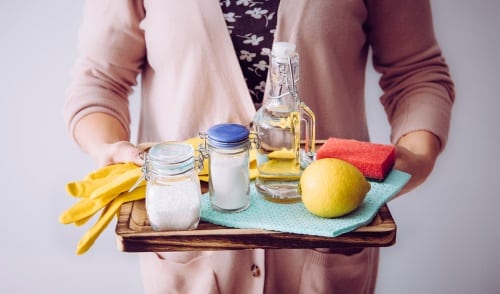
White spots on your treasured Calphalon pots and pans are disappointing, but you can usually fix them.
The whitish marks are normally caused by minerals in the cooking or washing-up water – usually lime or calcium. The white marks are not harmful, but they do spoil the look of your pots.
Read on for some tips on how to remove them as well as bonus information on how to take care of your Calphalon pans.
Calphalon is a US brand of cookware. The company is well known for its upmarket cookware. Many home cooks love their hard-anodized finish that is non-stick, scratch-resistant, and long-lasting.
The company realized in the 60s that if they used the technique of “hard-anodizing” on aluminum cookware, they could make it stronger and prevent it from corroding in the presence of acidic foods.
The hard-anodizing surface on Calphalon pots gives a non-stick, non-porous surface that will last for many years with the right care.
How to care for Calphalon pots and prevent white marks
- Do not leave the pan unattended, overheat, or open flame. Overheating damages the surface causing it to warp and discolor.
- Don’t use metal utensils as they will damage the surface; only use plastic or wood.
- Wash with non-abrasive sponges or cloths, not harsh scouring pads, and never steel wool.
- Calphalon cookware is better hand-washed as the dishwasher detergent may damage the non-stick surface.
- Store the cookware with paper towels in between each pan to prevent surface scratches.
- Dry the cookware after washing to prevent evaporation of the water which will leave behind the minerals and, consequently, white spots.
Why Are My Calphalon Pans Turning White?
The act of anodizing aluminum cookware creates a product that will not rust or pit and extends the life of pots, pans, and skillets.
Although durable, anodized aluminum pots are prone to white spots caused by minerals in the water.
Removing these white stains requires an acidic cleaner that breaks down the mineral compound without scarring the cleaning process‘s aluminum surface.
So, you can be assured that the finish on your pan is still there and is not wearing off. It is just an additional white layer on the pan that you need to get rid of.
What can I clean the marks off with?
1. A good, affordable acidic cleaner is ordinary household vinegar.
Vinegar consists of 5% acetic acid, which can dissolve lime and other minerals left on your cookware. Apple cider vinegar is slightly more acidic than ordinary vinegar, and this will also work well.
2. Salt and vinegar paste will also work well on stubborn marks because the salt will provide a slight abrasiveness while the vinegar works on dissolving the minerals.
Don’t use coarse salt as this will scratch the surface. Mix some salt and vinegar to make a paste, then gently rub the pan with it using a soft cloth. Wash with lukewarm water and mild soap. Rinse and dry well.

3. Baking soda and vinegar paste can be used in the same way.
If the spots are stubborn and still don’t come off, try leaving the paste on for about thirty minutes before washing off. This will give the vinegar more time to dissolve the mineral salts.
In conclusion
We hope these simple tips have helped you to get your Calphalon cookware looking spotless again. If cared for correctly, it will last you for many years and will give you endless hours of cooking pleasure. Let us know how you go – we’d love your feedback.